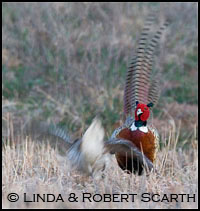introduction - galleries - technique - catalogue - notes - links - contact - blog - deep nature

Sharp-tailed Grouse & Pheasant
Show
Down at
It was still dark that morning when the compactly built, handsome male entered the lek to begin his display. He danced in the gray prelight as he kept an eye on the grass clumps hoping that the ladies who had been there the day before would reappear from the edges. Then even before the dawn spread its yellow pink warm glow over the scrub, a stranger swaggered onto the lek. Tall, robust, brilliantly colored and unwelcome, the Ring-necked Pheasant cock approached the Sharp-tailed Grouse while three grouse hens watched from the sidelines.
The pheasant?s demeanor was that of the territory owner rather than intruder. He walked onto the lek slowly, but confidently, with head and tail held high. As he neared the grouse, which was crouched and glaring at the pheasant in between short dance spurts, the pheasant assumed a bit more defensive posture as he anticipated the attack that was to come. The game little grouse jumped at the pheasant in a blur of wings. The bigger bird backed up a few steps and again came close. This happened several more times before the pheasant slowly strolled away and came back to repeat the sequence. He finally circled round some taller grass to watch from behind the grouse hens for awhile before moving down the trail, probably to return the following day.
In the mean time the grouse cock continued to dance near the ladies and twice chased another Sharp-tailed male off the lek. One time he followed the second male for some distance and then hurried back to check on the whereabouts of the pheasant before continuing his courtship display. Both birds were behaving as if the other was the intruder. The pheasant?s agonistic behavior was similar to that described in The Birds of North America, No. 572. His wattles inflated. He walked with head and rump held high, then crouched in an attempted face-off to which the grouse did not submit.
Ring-necked pheasants are known to harass and sometimes attack Greater, Lesser and Atwater?s Prairie Chickens when they are displaying. They also are documented as parasitizing nests of a variety of ground nesting species: Gray Partridge, all three prairie chicken species, Northern Bobwhite, King and Virginia Rails, American Woodcock, Wild Turkey, Ruffed and Blue Grouse, and upland-nesting ducks. Pheasants have a shorter incubation period than prairie chickens and some grouse. Though parasitism is infrequent, it can be a problem when compounded by other stressors. In some parts of the country, efforts are being made to control the pheasant population to allow the native species to retain the necessary habitat without being harassed. Endangered species like the Atwater?s Prairie Chicken are especially vulnerable to disturbance of any kind.
We found little information about the relationship of Sharp-tailed Grouse and Ring-necked Pheasants, other than a comment by a USFWS wildlife biologist interviewed in a Wyoming newspaper stating that pheasants push the grouse out of favorable habitats. And a DNR employee at Crex Meadows, where we watched the standoff, said he had reports of pheasant harassing grouse on the leks and that there were fewer grouse on the leks this year. A mild winter may have allowed more pheasants to survive.
These pheasant-grouse interactions are another example of introduced species becoming problematic for native birds that occupy the same habitats. However, much of the higher quality protected habitat available is provided through the good work and contributions of organizations like Pheasants Forever. Managing for multiple species is difficult but after observing the very tired Sharp-tail at the end of the morning display, we hope that more people serve pheasant for Thanksgiving dinner.
© Linda & Robert Scarth, 2007.
First published in NatureScape News, 2 (7), online, 2007.
